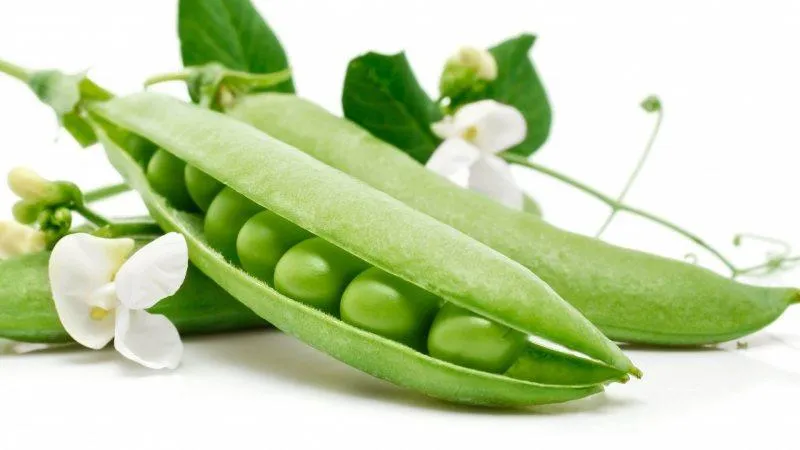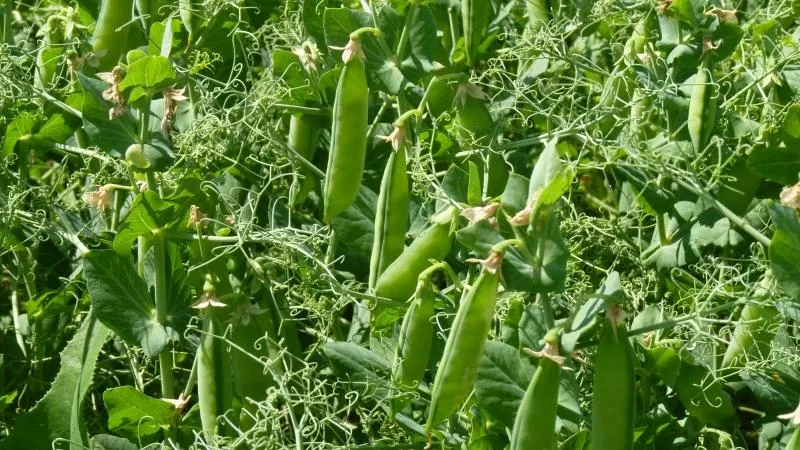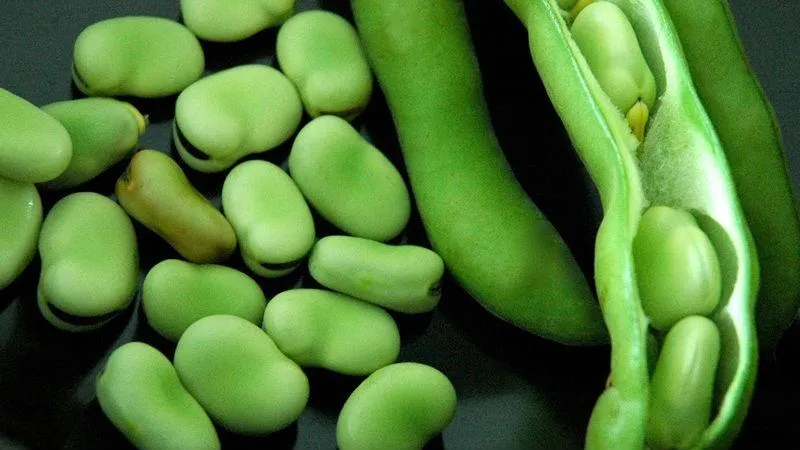Peas are an agricultural crop widely cultivated across Europe, particularly in regions with temperate climates. This popular crop is a favorite among gardeners, despite its somewhat demanding soil requirements. It offers numerous possibilities for culinary experiments and adds aesthetic value to home gardens. This article explores peas as a plant, their structure, and their climatic preferences.
Table of contents
Botanical Description
Peas are one of the fastest-growing leguminous crops. The vegetative period ranges from 65 to 140 days. Typically, self-pollination occurs in the closed-flower phase. However, during dry and hot summers, open flowering may occur, leading to cross-pollination. Flowering lasts 10-40 days.
The plant's life cycle is divided into four stages: germination, budding, flowering, and maturation. The last two stages exhibit clear layering—flowering and pod formation begin at the base of the stem and gradually move upward. This period also marks the peak of green foliage.

Growth Phases and Organogenesis Stages
Peas go through eight distinct growth phases.
| Phases | Organogenesis Stages and Key Processes | Formation of Yield Components |
| Seed germination | I — undifferentiated growth cone | Plant density per area |
| Seedling emergence | II — differentiation of growth cone, leaf and lateral bud formation | Plant habit — height, branching |
| Stem elongation | III — growth cone expansion, leaf formation on the shoot
IV — stipule and floral bud development V — differentiation of floral organs VI — formation of pollen mother cells VII — rapid stem and floral element growth. |
Number of pods |
| Budding | VIII — continued floral development, onset of fertilization | Number of seeds per pod |
| Flowering | IX — completion of fertilization, initial fruit growth | Number of seeds per pod |
| Pod formation | X — pod growth and development | Seed size |
| Seed filling | XI — seed growth, accumulation of assimilates | Seed size |
| Seed maturation | XII — conversion of nutrients into reserves | Seed plumpness |
Light and Temperature Requirements
Peas are highly light-dependent and suffer under insufficient sunlight. Therefore, they should be grown in open areas without shade from buildings or other plants. The planting area should also be well-protected from strong winds.
Peas begin to germinate at 1-2°C. Vegetative growth is optimal at 12-16°C. The ideal temperature range for development is 5-19°C. However, young plants can tolerate frosts down to -8°C.
Moisture Requirements
Peas are also highly sensitive to moisture levels. Water demand increases as the plant grows. Insufficient water reduces yield, while excess prolongs the vegetative period. Adequate hydration strengthens the stem and ensures plump, juicy pods.
The optimal soil moisture for peas is 70-80%. The most critical periods for water availability are flowering and pod formation.
Watering should be done once or twice weekly, with 10 litres per square metre. During hot, dry weather, this can be increased to 15 litres. Use a watering can with a fine spray for even distribution. Light soil aeration between rows after watering is recommended.
Soil Requirements
Peas thrive in balanced soils—avoid excessive nitrogen but ensure moderate mineral content. Fertile, neutral pH soil is ideal. Poor drainage or highly acidic soils are unsuitable.

Morphological Structure
Peas belong to the Fabaceae family. The most common cultivated species is Pisum sativum (garden pea). Below is a breakdown of its structure.
Root System
The root is taproot-type, penetrating up to 1 metre deep. Root nodules contain nitrogen-fixing bacteria, converting atmospheric nitrogen into plant-usable compounds.
Initially, the seedling root is a single primary taproot. Over time, secondary roots develop.
Stem and Leaves
The stem is herbaceous, hollow, and typically trailing. Supports such as trellises are used, as peas climb using tendrils. Stems can reach 2 metres in length.
Leaves are pinnate, with two opposite leaflets ending in a tendril. Leaf shape varies from oval to pointed, with net-like venation. Each leaf base has two semi-heart-shaped stipules that also contribute to photosynthesis. Leaves are arranged alternately.
Flowers
Flowers are butterfly-shaped (papilionaceous). Inflorescences are racemes with one or two flowers. Pea flowers are self-pollinating and usually white, pale yellow, or pink—rarely reddish or purple. Each flower has 10 stamens (9 fused, 1 free) and 1 pistil.

Fruit
Pea pods vary in shape—straight, curved, sword-like, or sickle-shaped. Pod length ranges from 4 to 12 cm, containing 4-10 seeds.
The edible seeds are round or slightly angular, typically green. Interestingly, the sweetest varieties often have wrinkled seeds. A cross-section of a pea seed is shown in the image.
Conclusion
Garden peas are a rewarding crop for any European gardener. Understanding their structure and environmental needs ensures a bountiful harvest. Key factors are ample sunlight, consistent watering, and proper support for climbing. With these in place, you’ll enjoy fresh, sweet peas straight from your garden.







